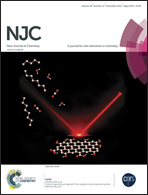Synthesis and characterization of N-doped TiO2 loaded onto activated carbon fiber with enhanced visible-light photocatalytic activity
Abstract
Nano-sized TiO2 particles are only excited under ultraviolet light irradiation and are difficult to be separated and recovered from the solution after the degradation reaction is complete. In this work, we have reported that N-doped TiO2 particles prepared via a sol–gel method were loaded onto activated carbon fiber (ACF) to fabricate a series of novel N-doped TiO2/ACF photocatalysts. The prepared N-doped TiO2 particles were in the anatase phase and the mean size of the particles was about 15 nm when heat-treated at 500 °C. Nitrogen atoms were incorporated into the surface of TiO2 mainly as interstitial nitrogen and molecularly chemisorbed γ-N2 molecules, and a little as substitutional nitrogen. N-doped TiO2 particles exhibit an evident red shift in the band edge and an obvious increase in visible region absorption, and the particles as a single particle are homogeneously dispersed on the surface of ACF. The results of the photocatalytic degradation of methyl orange show that N-doped TiO2/ACF photocatalysts exhibit enhanced visible light photocatalytic activity. This could be attributed to the synergistic effect between the strong adsorption of the ACF and the visible light photocatalytic activity by N-doped TiO2. The photocatalysts could be used for multiple degradation cycles without a decrease in the photocatalytic activity.


 Please wait while we load your content...
Please wait while we load your content...